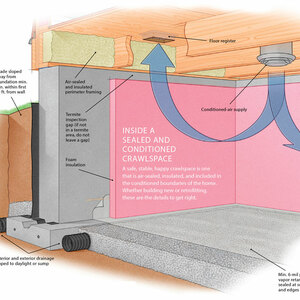*
I am in the process of planning to rebuild a Victorian era porch. The railings and balustrade are in varying poor condition with rot, layers of paint and breakage. I will need to recreate just about everything. My question is: what species of wood should I use? Cost is not much of a factor, it needs to be done right and preferably with native woods. The pieces will need to be painted white or I was thinking of using a cabot solid white stain (to keep the detail over time.) I have used the stain on cedar fences and have been happy with the results. Does anyone have any advice for me? Also the house is in a tough New Hampshire climate. Thank you in advance.
Discussion Forum
Discussion Forum
Up Next
Video Shorts
Featured Story

Ford Motor Company slashes prices for some F-150 Lightning models to stimulate demand for electric vehicles (EVs).
Featured Video
Builder’s Advocate: An Interview With ViewrailHighlights
"I have learned so much thanks to the searchable articles on the FHB website. I can confidently say that I expect to be a life-long subscriber." - M.K.

















Replies
*
Jim,
FHB has had several excellant articles over the years about detailing porches to prevent problems. Check out the index and order up those volumns!
*Use wood from the FYPON forest athttp://fypon.com/
*I've had success using cedar. I did several Victorian porches and they were on Long Island Sound. I had to recreate some of the balusters and used my William and Hussey molding maker. I created a profile on paper and faxed it to them to have cutters made. Did it right on the site. Worked like a charm. Just make sure the stain you use works well with cedar as cedar has resins in it that can bleed through. The original balusters were made of pine but the cost for cedar compared to clear pine was about the same so.....
*Thank you very much for your advice-- JL
*be careful faxing patterns like that. fax will distort scal and can produce a different profile. I learned the hard way.
*don't try to use any normally available pre-machined stuff for this project because 100 years ago every thing "wood" was much more substantial than the skinny stuff available today.There are some special mills that make the properly massed baulisters and posts, or you could have them custom machined.One thing to watch out for: modern code requires the railing to be higher than what was most likely originally used, so what ever you build will look skinnier than what it 'should' look like. To avoid the over-tall, over-skinny look that most fake victorian house's porch railings built today have you should increase the thickness of each element proportionally beyond even what was used for the original porch.Or, if you can rebuild it exactly as original due to 'grandfathering' that will save you some trouble (just don't fall over the railing, into the rose bushes, and then sue yourself).Or, you might not care about this 'purist' stuff and in that case don't worry about it. But now that I have restored one (most of the wood was save-able and only had to have a few parts custom made to match) all porches made with the common, off the shelf, 'victorian' details available today look whimpy and kinda wrong to my eyes.Abatron (advertises in FHB) sells really neat epoxy wood stuff that works wonders with rotted and softened wood. Four years later and mine still looks great (the super thin stuff will 'restore' punky wood by soaking into it and hardening and the thick stuff will make wood where it is missing altogether). But to use this stuff you need some of the original wood to start with, and your post indicated that it was all rotted away, but I mention this option just in case.
*I do period restorations in an area where the homes are very close to the beach and variable weather. I would suggest using clear cedar. If the cost of clear is too high, pick through some #2 cedar. And be sure to spot prime the knots, for they will bleed through. Be sure to check the required dimensions upon replacing your porch railing. If you were to restore the ballusts and put them back, you probably wouldn't need to adjust any spacing. I've found that on alot of old victorians the ballusts are spaced to wide for todays requirments. I used cabot stain years ago but have had problems with the stain fading on cedar. good luck.......
*fypon is pretty nice stuff . but being a true restoration perhaps wood is the preference. try cypress if cost is secondary concern. although cypress may be a challenge to find with long and large dimensions. go south my boy!! but there definitely not native. they have a northen white cedar,up in those parts i used on a large barn restoration. like it made my own novelty drop siding, doors windows. the key to longevity is the priming. i know all pretty good amount victorian restorations with brackets i laminate 1/ 4 inche pieces for 4/4 true restoration dimension breaks the grain up . well anyhow good luck
*
I am in the process of planning to rebuild a Victorian era porch. The railings and balustrade are in varying poor condition with rot, layers of paint and breakage. I will need to recreate just about everything. My question is: what species of wood should I use? Cost is not much of a factor, it needs to be done right and preferably with native woods. The pieces will need to be painted white or I was thinking of using a cabot solid white stain (to keep the detail over time.) I have used the stain on cedar fences and have been happy with the results. Does anyone have any advice for me? Also the house is in a tough New Hampshire climate. Thank you in advance.